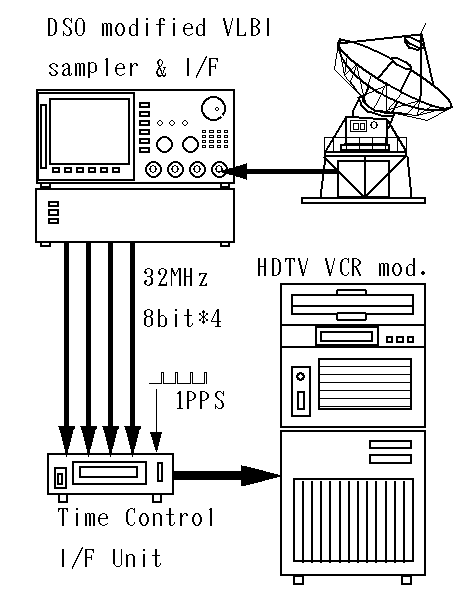
Figure 1. 1024Mbps VLBI terminal.
Joint Japanese group (NRO, ISAS and CRL) have started to develop
new VLBI terminals. This system will standardize surprisingly high speed
aquisition (1024M-bits per second) in the near future. To establish high
sensitivity in VLBI observations, which enables observations of the
weak distant QSO, we must make better use of the receiver bandwidth.
Ground based VLBI is limited by the radio telescope aperture size and
the integration time due to the atmosphere. Development of both the
High Speed Sampler and the High Speed Data Storage has started. This
equipment will be employed as the next Japanese VLBI standard
terminal (Fig.1). We will name the system brand new "J-1" or something
which indicate the difference from the K-4 series.

The High Speed Sampler is designed to sample the data rate of 1024/512/256MHz 1/2/4ch 1/2bit selection. The baseband signal is supplied from the NRO wide-band video converter which receive 5 to 7GHz IF optical transmission. The sampler is equipped with the external time code input. When the correlation system needs the time code, it can insert a user programmable one. We will use the DSO (Digital Storage Oscilloscope) AD-aquisition module for the sampler. The continuous sampling DSO provides the function of selection of various rates and channels. Hence we are using the DSO, this sampler can monitor the input signals directly. This is convenient to adjust the signal level. The sampler applications to the interferometer and the digital spectrometer components are possible.
The High Speed Storage System will reach the 1024Mbits/sec
recording. To achieve the first ever performance in VLBI, we are
modifying the HDTV-VCR (High Definition TV Video Cassette Recorder).
This recorder is designed for multi-HDTV-formats. VLBI raw data is
recorded as the part of HDTV frame data. Error rate is better than
10^10. The recorder time sequence is controlled by the newly designed
VLBI interface. The interface is arranged to record the
data without time code. Playback speeds of 1/2 to 1/32 are possible for
the low-data rate correlation system. Some of the initial
specifications of the VCR did not reach our targets, and we are trying to
increase the performance.